IFS is committed to making an impact and contributing to make the world a better place, through its Corporate Social Responsibility Program and The IFS Foundation. IFS is proud to partner with Tony Hawk this year at the IFS World Conference and highlight the work of the Tony Hawk Foundation. Below is a blog written by guest blogger, Tony Hawk.
Skateboarding is great. Skateparks make skateboarding greater.
The skateboard is a fascinating vehicle by itself, but its potential is only truly unlocked when used in a place designed for it. Skateboarders have embraced the benefits of skateparks for decades, and now (finally, it seems) city leaders everywhere are also seeing the value. Demand for new public skateparks is at an all-time high.
I was lucky to have a skatepark near me when I was growing up and it had a lasting impact on my approach to life. The Del Mar Skate Ranch was my home-away-from-home. I honed my skills there for years before I was doing the kinds of tricks I have become known for in recent decades. I found my tribe at DMSR; people from diverse backgrounds knew me and we had a shared sense of belonging. We all came to skate, have fun, share ideas and maybe learn a new trick. Skateboarding was our common ground and dialect.
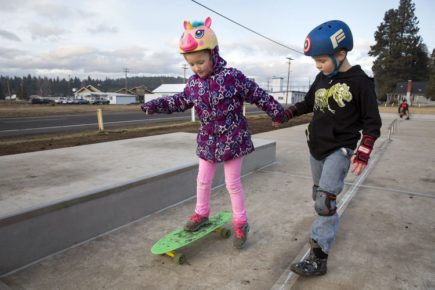
People interacting at the skatepark is a common sight… Two kids help each other out at the skatepark in Chiloquin, Oregon; Tony Hawk Foundation’s 541st skatepark.
At the park it was easy to meet new people. I was shy at school, but I found lifelong friends at the skatepark and many of us still skate together, nearly 30 years later. My early skatepark experiences were the most formative.
Today there are around 3,500 public skateparks in the United States, catering to roughly 5-million skaters. Community leaders have seen what these skateparks offer and have gotten on board (pun intended) but there’s still much work to do. Some things are getting easier, others have become more challenging.
The obstacles to new skateparks have changed over the years. Skateparks were once considered the center of predictions around the end of the neighborhood’s quality-of-life as we know it. City leaders, bowing to fierce NIMBY opposition (“Not In My Back Yard”), would often deny their younger residents recreational access for fears that never manifest. Today, the skatepark conversation is instead dominated by a lack of funding. Communities are finally starting to come around. Today, the value of skateparks is recognized by the community even if the funding mechanisms aren’t there yet. Skatepark approvals and planning are more efficient than ever, but they still require years of community fundraising.
Decades of doomsday predictions describing hordes of insolent teenage boys defiling pristine suburban neighborhoods with their noise, garbage, graffiti, injuries, and lawsuits never materialized. Horrified municipal risk assessors can now sleep easy knowing that there won’t be a flood of liability claims from accidents. Even some people who opposed skatepark originally have confessed they were wrong.
There may be places to skate around town, but nothing can replace a purpose-built skatepark. A parking garage can be decent terrain, but it should never be the best (or only) place to skate. Half of the nation’s youth still don’t have access to a public skatepark. For these millions, the only option is skating in the streets and around town … wherever they can. These skaters are just looking for a place to ride their board without cops, cars, and cracks.
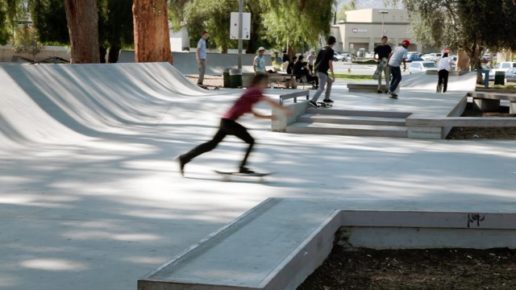
A skater pushes through the Lanark Rec Center Skatepark in the Canoga Park neighborhood of Los Angeles, California. Every skatepark is unique and enjoys a kind of provincial pride. Lanark Skatepark opened in 2011 and was THF’s 489th skatepark.
Skateparks Bring It Together
Skateparks are bustling hubs of creativity and constant motion. A busy park may look like a chaotic mash-up of people on all kinds of things going in every direction. In a minute or two the patterns emerge; skaters taking turns and negotiating with each other wordlessly as they share the space. Collisions are avoided through eye contact and body language, among other things. There’s a kind of etiquette, language, and rhythm to a skatepark that doesn’t exist anywhere else.
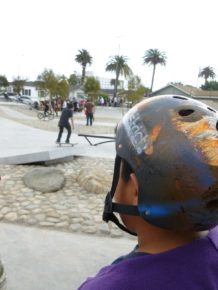
A young skater watches the action at the Ernie McBride Skatepark in Long Beach, California. The local skatepark is a safe place to hang out with people who share a common interest. The Tony Hawk Foundation supported this skatepark in 2010 with a $45,000 construction grant.
One thing you’ll see is lots of different kinds of people sharing the space. At the skatepark it would be perfectly ordinary to see a young skater giving advice to an adult. It is normal to see beginners sharing the same parts of the park as experts, as peers.
Sometimes a skatepark’s specific location in a community has a major impact on community health—particularly in places that struggle with high levels of youth crime—and so young people from adjacent neighborhoods can meet at the “neutral” skatepark. The skatepark is often where skaters who have used gear give that stuff to skaters in need. It is where skaters find each other. People from different neighborhoods, backgrounds, and persuasions peacefully share and interact in these spaces.
At the skatepark you’ll see many young people moving swiftly through a shared space without any kind of visible traffic management or adult direction. The park visitors learn, in time, a particular kind of situational awareness the skaters use to pay attention to the other users of the space, hazards in their path, and a focus on the trick or technique they’re performing. This technique requires a certain kind of focus you might not experience anywhere else.
I love seeing how a patch of sculpted concrete can attract so many people. The skateparks we support are all free to visit and are located in places that young people can access. The same skaters who volunteered years of their time advocating and raising funds for a new facility are directly involved with its design. Local youth who worked for the skatepark can see the positive impact their efforts have had on the lives of their friends and community. And because the skateparks are concrete and skateboard wheels are urethane, these parks require only simple routine maintenance which appeals to thrifty and less affluent communities.
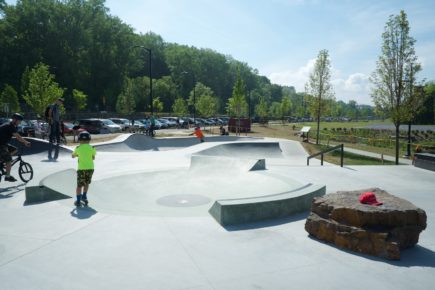
Skatepark designs often incorporate natural elements like this large rock permanently featured at the skatepark in Burlington, Vermont. This was the Tony Hawk Foundation’s 500th skatepark.
With the skatepark, the community gets a new, vibrant place to go and the local government gets a popular recreational attraction with low maintenance. The skatepark brings new people to the activity and so, in time, the facility becomes a community landmark.
There is a profound sense of community pride when a skatepark gets built. It’s the skateboarders themselves who are responsible; it wasn’t just an act of charity by community leaders.
Every skatepark is the result of local volunteers, skaters and their allies, campaigning in their community for years—spreading awareness, gathering support, and raising funds. These projects take over three years to finish, from the first community meetings to discuss the path forward until the ribbon-cutting celebration. A new public skatepark requires many factors to be built and the local skate community is proud to take the lead every step along the way.
Tony Hawk Foundation Gets It Done
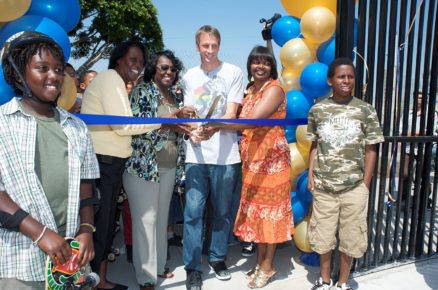
Tony Hawk helps cut the ribbon at the grand opening of the public skatepark in Compton, California, which received a grant from the Tony Hawk Foundation.
I established the Tony Hawk Foundation in 2002 to help young people in low-income communities produce quality public skateparks to service their areas. One way we accomplish this is by providing guidance to city officials and volunteers as they face critical decisions. To-date, the foundation has awarded over $9-million to over 600 public skatepark projects in all 50 states, and additional support to the Skateistan programs in Afghanistan, Cambodia, and South Africa.
The ultimate proof that skateparks work for young people is in their attendance. Communities supported by the Tony Hawk Foundation routinely claim, months after opening day, that the local skatepark is their most popular public facility among all of their recreational attractions. Every day THF fields queries from communities around the world seeking help with their new projects, expansions, renovations, and more. Skateboarding youth are asking for more help than we can provide.
The Tony Hawk Foundation’s mission is to support these communities by providing technical support and construction grants. Eligible communities are able to demonstrate that their new skatepark is led by and will be used by local youth, and can measure their need for a skatepark in tangible ways.

Specialty design and construction ensures that every curve and ledge is perfect. Exacting standards and plenty of community oversight ensure that every park THF supports is sustainable and built to last. Experienced skatepark builders are busy here shaping concrete at Echo, Oregon’s skatepark. THF’s 350th skatepark was granted in 2007.
The skatepark will have people in it almost every hour of the day. Once it has opened, the “one thing” that Parks Planners usually regret is that they didn’t make the skatepark larger. A significant portion of THF’s skatepark-construction applications come from park-expansion projects. THF’s focus remains on those communities that currently have no place to skate … but communities everywhere are seeking help with their projects. In this environment of unmet need, innovation and community engagement emerges.
Today there are thousands of skateparks around the world, and each one of them is providing thousands of hours of recreation and exercise in a fun, meaningful way. Wherever they are built, they bring people together. Small towns have skateparks that serve as a gathering place for young people across the region to meet, relate, and build social connections. In larger cities and metropolitan areas, skateparks serve as a safe place to skate, away from motor vehicles and places where it may be illegal or dangerous. Everywhere they are located, skateparks bring people together where they can do something that they love in a safe environment.
For more information about Tony Hawk, visit: www.tonyhawk.com
For more information about the Tony Hawk Foundation, visit: www.tonyhawkfoundation.org
For more information about The IFS Foundation: https://www.ifsworld.com/us/company/about-ifs/csr/
Do you have questions or comments?
We’d love to hear them so please leave us a message below.
Follow us on social media for the latest blog posts, industry and IFS news!
Photo: Robson Hatsukami Morgan